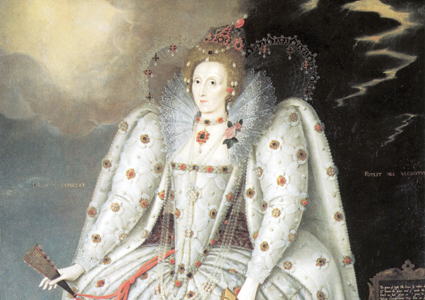Wilson, A.N. The Elizabethans, Farrar, Straus and Giroux, New York, 2012 (448pp.$30)
The queen died unhappy, ravaged by time and illness, her realm disquieted by civil and religious factions that were equally adumbrated by frequent outbreaks of plague. The magistrates and sheriffs were hanging thieves, brigands and cut-purses in droves. In February 1603 Elizabeth was able to receive the Venetian ambassador to the English court who had come to London complaining about English pirates and corsairs preying on Spanish and Venetian vessels in the Adriatic. In his diaries the ambassador reported that the queen had a light-colored wig (“hair not made by nature”) and wore great pearls like pears around her forehead. She also bore a great quantity of gems and pearls on her person and even under her gown she was covered with golden-jeweled girdles and single gems, carbuncles, rubies and diamonds. Around her wrists were double rows of pearls of “more than medium size.” But the paper-thin skin of her face was splotched and her few teeth blackened with rot. And then in March the great queen died, her finger so swollen that the Coronation Ring bestowed on her 55 years before had eaten into her flesh and had to be sawn off. Only then could she be separated from power.
A.N. Wilson, prolific author of historical works, novels and critical investigations (including the recently published “Dante in Love” and “The Victorians”) has written a highly readable history of the mid-16th century that he dubs the “birth of modern Britain”. Whether that is so, the reader should decide.Suffice it to say that “The Elizabethans” is painterly in its delicious sweep, occasionally obstreperous in its reasoning, and wholly enjoyable for its cast of characters, most of whom are doubly or trebly deceptive: After all, it was an age in which an explorer, pirate and slave-runner could also be a poet and playwright. Sir Walter Raleigh comes to mind, a man who not only colonized parts of the American eastern seaboard, searched hopelessly for diamonds and El Dorado along the Orinoco delta, but who also composed histories of the world and love lyrics, finally losing his head in the Tower to the ax of political intrigue. Another, Sir Francis Drake, not only performed the first circumnavigation of the world (Magellan having died in the Pacific on his quest), but also made a fortune slave-trading and buccaneering, later helping to defeat the Spanish in the English Channel as an Admiral.
This was the age of Shakespeare and his shadowy doppelganger Christopher Marlow, who write great plays, spied or double-spied for Francis Walsingham’s Stalinesque bureau that kept track of all the epic plots and counter-plots of the time (and who was stabbed to death in a pub fight), of epic poet Sir Philip Sidney (who also killed Irish peasants while working for the governor) and the administrator and treasurer Robert Cecil, who ran the government with an iron hand. Naturally, the fight with Spain and its Catholicism looms large, as does the beheading of Mary Queen of Scots, Elizabeth’s primary enemy for England’s throne. Even Elizabeth’s flights of love-sickness over Robert Dudley and the second Essex, so well known by now, are given their due. Perhaps the period really did give birth to modern Britain, in the sense that it birthed the outlines of the modern state altogether, with its intrigue-ridden administration, its obsession with money and civil order, its brutal colonization of helpless peoples like the Irish whom the state murdered by the hundreds of thousands, its teeming masses headed for the city where there waited gin and degradation, and of course, the flag-waving knee-jerk nationalism which has come to be the hallmark of modernism itself.
Many books have been written about the Elizabethan Age. One could do worse than Wilson’s as a beginning, considering how well made it is with its considerable attention to detail (its studies in architecture, exploration and disease are alone worth the price of admission), its lustrous illustrations, ample bibliography and substantial index. And despite its occasional journalistic off-handedness in phrase, “The Elizabethans” remains an entertaining and useful popular history.


